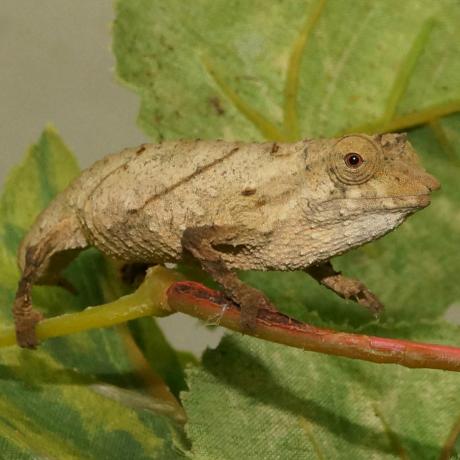

A small but fascinating species of pygmy chameleon from mainland Africa, also known as the Cameroon stump-tailed or western pygmy chameleon.
| Origin | Central and western Africa |
|---|---|
| Environment | Costal lowlands and montane rainforests |
| Adult Size | Up to 9cm |
| Suitability | Experienced |
| Lifespan | Unknown |
| Temperament | Docile |
A small-sized chameleon, with adults reaching a size around 9cm (3.5") total length. Like most other pygmy chameleons, Rhampholeon spectrum bodies are elongated, high in shape, and laterally compressed, this makes the head difficult to distinguish from the main part of the body. A small conical process protrudes from the nasal area and resembles that of a horn. The tail is short, albeit prehensile, and is the only accurate way to determine the sex of this species, with males only, have an enlarged tail base.
The overall base colouration is quite uniform in colour and made up of varying shades of grey, brown and black. This species commonly displays dark lateral stripes down its flanks.
Much of the well-known localities of this species, include costal lowlands and montane rainforests. Despite being widespread they are only found in isolated areas across central and western Africa including, eastern Nigeria, Cameroon, Gabon and Equatorial Guinea including the Democratic Republic of Congo.
Although this species shows little intraspecific aggression they do not fare well in social groups and are best kept singular or in sexed pairs.
We'd recommend a glass terrarium of 45x45x45cm in size, as this will be large enough for exploring chameleons and provide ample space for a range of different décor items.
Daytime temperatures should be maintained between 22-24°C (72-75°F) during the day, with a night-time drop to 20°C (68°F). In our experience, pygmy chameleons are not fond of high wattage basking spots and will purposely avoid these areas. Use smaller compact bulbs within a canopy hood to reach the desired temperatures. If you measure the temperatures carefully with a digital thermometer you may find that your UVB lights give enough heat on their own without the need for additional heating equipment. This will depend entirely on your ambient room temperature.
Provide a 5% UVB fluorescent lamp to simulate natural daylight and to aid calcium and vitamin D3 absorption.
Maintain a high humidity level by spraying the enclosure daily with tepid water, when doing this, you will see pygmy chameleons actively drinking water droplets from cage décor. You can provide a water bowl but it will be largely ignored, however, it will help raise ambient humidity in the enclosure so is therefore beneficial.
For cage décor, provide cork oak branches or bark, combined with vines and live or artificial plants. Ensure you fill out the enclosure well, to provide plenty of coverage and so that your pygmy chameleon feels secure. Use a soil based substrate to cover the floor of the enclosure and add sphagnum moss for decoration and to help maintain humidity levels.
Pygmy chameleons are insectivores and will eat an array of different live food. Favourites are crickets, curly-wing flies, mealworms and waxworms. We've also found it beneficial to place tropical woodlice and springtails into the enclosure, not only does this provide an alternate food source, they are fantastic clean-up crews!
Lastly and most importantly you must use a good quality dusting powder to provide essential calcium and vitamins to your pygmy chameleons. The traditional method of application is to use a spare live food tub or empty cereal container to coat the insects lightly in the powder. Apply dusting powder to your insects on every feed for juvenile chameleons and ensure you alternate between calcium and vitamin powders with the ratio of (2.1). For adults, the frequency of dusting is less important, but the basic princple must be maintained to keep your chameleon in good health.